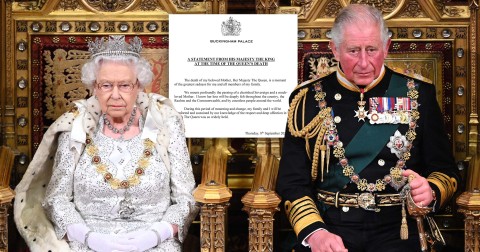
Britain has a new monarch after the death of Queen Elizabeth II earlier on Thursday, September 8, with the ascension of King Charles.
The King has said the death of his mother, Queen Elizabeth II, ‘is a moment of the greatest sadness’ for him and the Royal Family.
Read Also: Queen Elizabeth II: Double Rainbow Sighted Outside Buckingham Palace After Monarch’s Death (VIDEO)
The new monarch, who Clarence House confirmed will be known as King Charles III, said in a statement released by Buckingham Palace.
The death of my beloved Mother, Her Majesty The Queen, is a moment of the greatest sadness for me and all members of my family.
We mourn profoundly the passing of a cherished Sovereign and a much-loved Mother. I know her loss will be deeply felt throughout the country, the Realms and the Commonwealth, and by countless people around the world.
During this period of mourning and change, my family and I will be comforted and sustained by our knowledge of the respect and deep affection in which The Queen was so widely held.
New heir to the throne William and wife Kate’s Twitter account @KensingtonRoyal now refers to the couple as The Duke and Duchess of Cornwall and Cambridge.
Dressed in black, Ms Truss – who was welcomed by the Queen as the nation’s new PM a mere 48 hours ago – addressed the nation outside No 10.
She said;
We are all devastated by the news that we have just heard from Balmoral.
The death of Her Majesty the Queen is a huge shock to the nation and to the world.
Today the crown passes, as it has done for more than 1,000 years, to our new monarch, to our new head of state, His Majesty King Charles III.
Ms Truss said the country would now support the King.
She went on;
We offer him our loyalty and devotion, just as his mother devoted so much, to so many, for so long.
And with the passing of the second Elizabethan age, we usher in a new era in the magnificent history of our great country, exactly as Her Majesty would have wished, by saying the words “God save the King”.’
Mourning Rites
The royal family and their households traditionally enter into Court Mourning following the death of a sovereign.
The length of time spent in Court Mourning has varied throughout history, with the details decided on by the new monarch and the instructions published in the London Gazette.
When George VI died in February 1952, the royals, on the order of Elizabeth II, observed Court Mourning for just over 16 weeks – much shorter than previously.
After George V’s death in January 1936, the court, on the orders of Edward VIII, went into full Court Mourning for six months, followed by three months of half- mourning.
When Queen Victoria died in January 1901, the court went into mourning for an entire year.
The Lord Chamberlain’s Office issued instructions including;
Ladies to wear black Dresses, trimmed with Crape, and black Shoes and Gloves, black Fans, Feathers, and Ornaments. The Gentlemen to wear black Court Dress, with black Swords and Buckles.
After six months, women at court were allowed to wear black dresses, with coloured ribbons, flowers, feathers, and ornaments, or alternatively grey or white dresses, with black accessories, while men continued with the same mourning clothes.
When Prince Albert died, Queen Victoria gave instructions that the public mourning for the Prince Consort should be ‘for the longest term in modern times’.
Members of the royal household did not appear in public out of mourning for a year.
